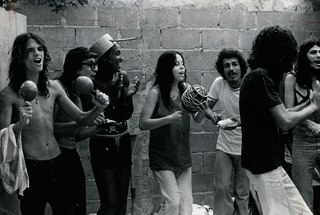
Hermeto Pascoal is a Brazilian composer and multi-instrumentalist. He was born in Lagoa da Canoa, Alagoas, Brazil. Pascoal is a significant figure in the history of Brazilian music, mainly known for his abilities in orchestration and improvisation, as well as being a record producer and contributor to many Brazilian and international albums.

Titãs are a Brazilian rock band from São Paulo. Though they basically play pop/alternative rock, their music has touched a number of other styles throughout their 40-year career, such as new wave, punk rock, grunge, MPB and electronic music.

Pedro Anibal de Oliveira Gomes, better known as Pepeu Gomes is an accomplished Brazilian guitar player, multi-instrumentalist and composer. He was one of the members of Novos Baianos.

Baby do Brasil, equally known as Baby Consuelo, is a Brazilian performer, singer and composer.

Titanomaquia (Titanomachy) is the seventh album released by Brazilian rock band Titãs, released on 10 July 1993. All songs are credited to the band as a whole, as it happened in the previous album, Tudo Ao Mesmo Tempo Agora. Also, it marks the first time Jack Endino worked with them, the only foreign one they ever worked with.

Go Back is the first live album by Brazilian rock band Titãs. It was recorded on 8 July 1988 at the Montreux Jazz Festival in Switzerland and released on 14 October of the same year.

Som Livre is a Brazilian record company that was founded in March 1969 in order to commercialize the soundtracks for Rede Globo soap operas. It later expanded to recording studio albums.

Novos Baianos were a Brazilian rock and MPB group founded in Salvador, Bahia in 1969. The group was active between 1969 and 1979, enjoying success throughout the 1970s. The group had reunions in 1997, 2015 and 2020 respectively. Together, the group recorded eight full-length studio albums, as well as two live albums.

"Sonífera Ilha" is the debut single by Brazilian rock band Titãs, released in 1984. The song, as well as its b-side "Toda Cor", was co-composed by Ciro Pessoa, one of the lead singers and founding members of the group, who would leave the band before the release of their first, self-titled album, in which the single and the b-side were included. "Sonífera Ilha" is among a few of Ciro's contributions to Titãs.

Acabou Chorare is the second studio album by Brazilian rock and MPB group Novos Baianos. The album was released in 1972 by Som Livre, following the group's moderately successful debut É Ferro na Boneca (1970). During the recording of the album, the group took inspiration from various contemporary artists of the time, such as Jimi Hendrix, João Gilberto, and Assis Valente. In addition, Gilberto heavily influenced the sound of the album, as he served as the group's mentor during the album's recording sessions.

Armandinho is a Brazilian composer and singer. He was born in Salvador, the son of Osmar Macêdo, from the world's first trio elétrico, the Trio Elétrico de Dodô e Osmar. In his early career, he played in his bands Trio Elétrico Mirim in 1962 and Hell's Angels in 1967.

Sandy Leah Lima, known mononymously as Sandy, is a Brazilian singer-songwriter and actress. Born and raised in Campinas, Sandy began her career in 1989, when she formed with her brother, musician Junior Lima, the vocal duo Sandy & Junior. They rose to fame in the early 1990s as child stars and reached the height of their success during teenage, as albums Era Uma Vez... Ao Vivo (1998), As Quatro Estações (1999), Quatro Estações: O Show (2000) and Sandy & Junior (2001) sold more than a million units, with the second and third being among the best-selling albums of all time in Brazil. The duo were credited with leading a wave of teen pop artists during the late 1990s and early 2000s, with the press labelling Sandy the Brazilian "Princess of Pop". The duo disbanded in 2007 and released their Acústico MTV in September that year. In addition to their success in the music industry, the sibling's name became a strong brand, with more than 300 licensed products which made R$300 million a year.

Thiago André Barbosa better known as Thiaguinho, is a pagode singer, composer and presenter. He first gained notoriety for participating in the talent show Fama in 2002 and became famous for being a member of the musical group Exaltasamba from 2003 to 2012. In 2012, he released his first solo album and live album, "Ousadia & Alegria", selling more than 80,000 copies and earning him a Latin Grammy nomination in the Best Samba/Pagode Album category. He released his second solo album, "Outro Dia, Outra História", in 2014 which sold 40,000 copies and earned a gold record certificate. His third album, "Hey, Mundo!" was released in 2015, and was a commercial success, selling more than 160,000 copies and going double platinum. His second live video recording, "VamoQVamo" was released in 2016. In the same year, he released another album called "Tardezinha". His "Só Vem" album was released in 2017 which sold 40,000 copies and earned him another gold record. He released "Tardezinha 2" in 2017, followed by his third live recording called "Vibe" in 2020.

Antônio Carlos Moreira Pires, better known as Moraes Moreira, was a Brazilian musician and songwriter. During the 1970s he played guitar and sang in the band Novos Baianos, after which he embarked on a solo career recording 29 albums. Moreira was involved in recording 40 full-length albums with Novos Baianos and Trio Elétrico Dodô e Osmar, and two more albums with guitarist Pepeu Gomes. Moreira was one of the most versatile composers of Brazil, mixing the genres of rock, samba, choro, frevo, baião, and classical.
Paulo Roberto Figueiredo de Oliveira, better known as Paulinho Boca de Cantor, is a Brazilian singer and composer. He was a founding member of the band Novos Baianos, and performed with them from 1969 to 1979.

Doze Flores Amarelas is the fifteenth studio album by Brazilian rock band Titãs, released in parts from 27 April to 11 May 2018. It is the band's first album via Universal Music, the first without vocalist, guitarist and founding member Paulo Miklos and the first with his session replacement Beto Lee, son of Brazilian rock singer Rita Lee, who guest performs on the album with narrations.

Renato Teixeira de Oliveira is a Brazilian singer-songwriter. He is a representative of sertanejo music and folk rock, linked to the caipira culture and dialect. Teixeira is the author of several hit songs including "Romaria", which was notably covered by Elis Regina in her eponymous 1977 album. Other hit songs by Teixeira were "Dadá Maria" and "Tocando em Frente", later sung also by Maria Bethânia. Teixeira won twice the Latin Grammy Award: in 2015 for Best Sertaneja Music Album, with Sérgio Reis, and in 2016, with Sater. His album +AR was ranked as the 44th best Brazilian album of 2018 by the Brazilian edition of Rolling Stone magazine and among the 25 best Brazilian albums of the second half of 2018 by the São Paulo Association of Art Critics.
Maneva is a Brazilian reggae band from São Paulo.
Black Pantera is a Brazilian crossover thrash band founded in Uberaba, Minas Gerais, in early 2014. Formed by Charles Gama, Chaene da Gama (bass) and Rodrigo "Pancho" Augusto (drums), all of them African-Brazilians, the band discusses topics such as politics, racism and discrimination in general in its lyrics, among other topics; its name is inspired by the Black Panthers.

Titãs Trio Acústico is the sixteenth studio album by Brazilian rock band Titãs Released throughout 2020 by the BMG label, the EPs bring together acoustic versions of a total of 24 songs previously released by the group. Initially divided into three EPs throughout 2020, the disc won a full version on January 29, 2021, also on a physical double CD, bringing together the 24 tracks from the three EPs.

















